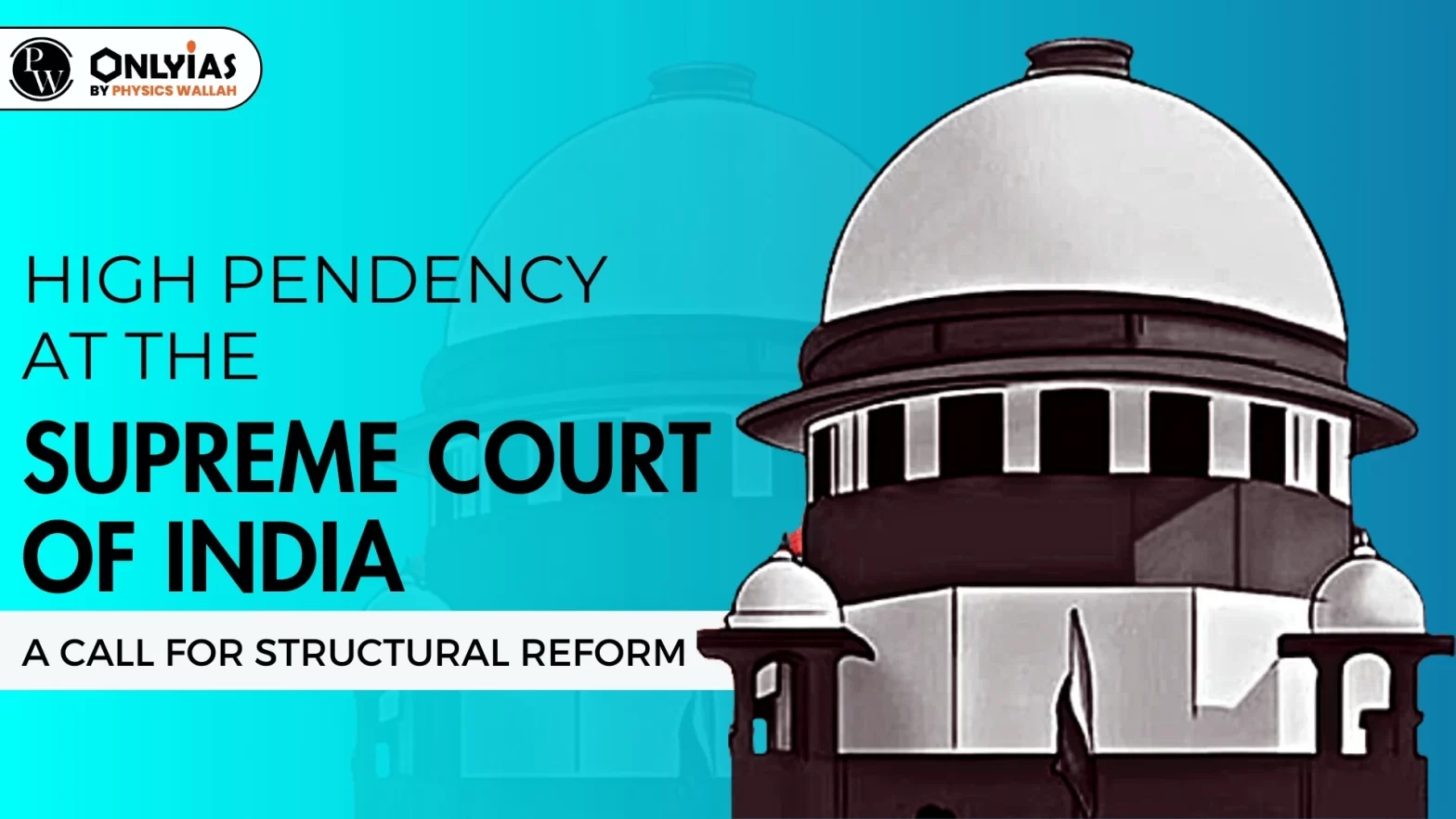Context: This article is based on an Editorial “It’s time to revamp the structure of the Supreme Court of India” Which was published in the Hindu. Currently, the Supreme Court of India is facing a high pendency of cases (79,813 cases), which is raising a demand for a structural change.
- Recently, the Chief Justice of India (CJI) also announced his intent to create constitutional benches of varied strengths as a permanent feature of the Court.
| Relevancy for Prelims: Supreme Court of India.
Relevancy for Mains: Concern of High pendency of Cases in the Supreme Court and Way Forward. |
Historical Background of the Supreme Court of India:
- During the colonial Era: There were three Supreme Courts- in Bombay, Calcutta, and Madras.
- The Indian High Courts Act of 1861: It replaced the Supreme Courts with High Courts for separate regions.
- The Government of India Act, 1935: It created the Federal Court of India as an appellate body for the Privy Council and High Courts.
- Indian Constitution: The present Supreme Court was founded on January 28, 1950, under Article 124 of the Constitution.
- It came into being in Delhi as a result of Article 130.
- Increase in number of Judges: The first Supreme Court included eight judges, including the CJI. With time and need, Parliament increased the number of judges from eight in 1950 to 11 in 1956, 14 in 1960, 18 in 1978, 26 in 1986, 31 in 2009 and 34 in 2019.
Features of the Supreme Court of India:
- Types of Jurisdiction: The Supreme Court of India has three jurisdictions under the Constitution- original, appellate, and advisory.
- Hearing of Cases: These are heard by Division Benches (of two judges) or full Benches (three judges) to examine a wide range of topics, such as film prohibitions/restrictions.
- Broad Jurisdiction: It includes public interest litigations, such as secularism be removed from the Preamble to the Constitution.
- Serving: The Supreme Court serves as a Constitutional Court as well as a Court of Appeal.
- Benches: The Court sits in benches of varying sizes, as determined by the CJI (the Master of the Roster).
- Constitution Benches: Provision is provided in Article 145(3) of the Constitution.
- Article 143: For hearing any reference that deals with the power of the President to consult the Court.
- Composition: It typically comprises five (minimum), seven, or nine judges, deliberating on a substantial question of law as to the interpretation of the Constitution.
What is the primary reason for the high pendency of cases in the Supreme Court of India?
- The Supreme Court of India hears matters between the Centre and the States, as well as between two or more States, and rules on civil and criminal appeals.
- It provides legal and factual advice to the President.
- On infringement of fundamental rights, any person can also immediately petition.
Discourse on a Separate Constitution Bench:
- Tenth Law Commission of India (1984): It proposed that the Supreme Court of India be split into two divisions: the Constitutional Division and the Legal Division.
- Eleventh Law Commission (1988): It states that dividing the Supreme Court into parts would make justice more widely available.
- The Supreme Court (1986): In Bihar Legal Support Society vs. Chief Justice of India (1986), the Supreme Court of India expressed a desire to establish a National Court of Appeal. This would allow the Supreme Court to only entertain constitutional and public law-related questions.
- The 229th Law Commission Report (2009): It recommended four regional benches (Delhi, Chennai or Hyderabad, Kolkata, and Mumbai) to hear non-constitutional issues.
- It could help the Supreme Court to deal with constitutional issues and other cases of national importance on a day-to-day basis.
Also Read: Law Commission Of India
The Path Ahead:
- Split of the Work: As suggested by various important bodies, the work of the Supreme Court of India could be split so that there is a Final Court of Appeal and a permanent Constitution Bench to ensure greater judicial stability and consistency.
- Need to address the Structural Gap: By designating several of the court’s appeal benches as regional benches.
- The Constitution Bench (V. Vasanthakumar vs. H.C. Bhatia) is analyzing these issues and considering measures to protect citizen’s basic right to access the Supreme Court.
Conclusion:
Addressing the high pendency of cases at the Supreme Court of India necessitates a thoughtful structural reform, possibly through the establishment of regional benches and a dedicated Constitution Bench, as deliberated in ongoing judicial considerations.
| Prelims Question (2014)
The power of the Supreme Court of India to decide disputes between the Centre and the States falls under its
(a) Advisory jurisdiction
(b) Appellate jurisdiction
(c) Original jurisdiction
(d) Writ jurisdiction
Ans: (C) |
To get PDF version, Please click on "Print PDF" button.

